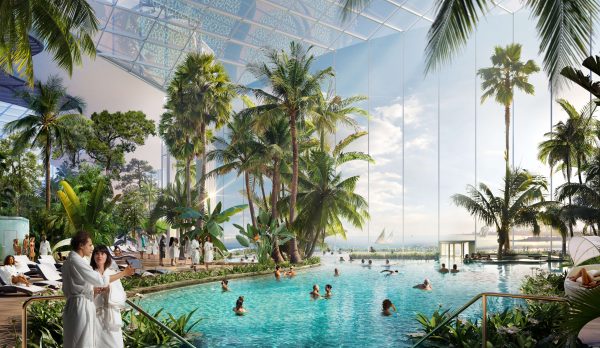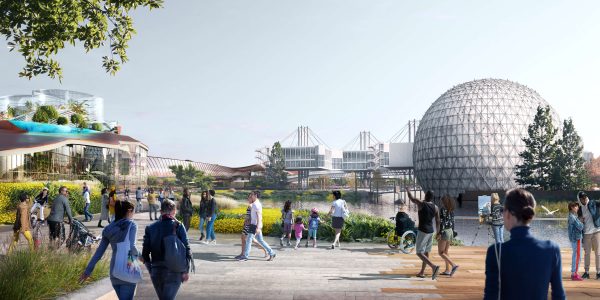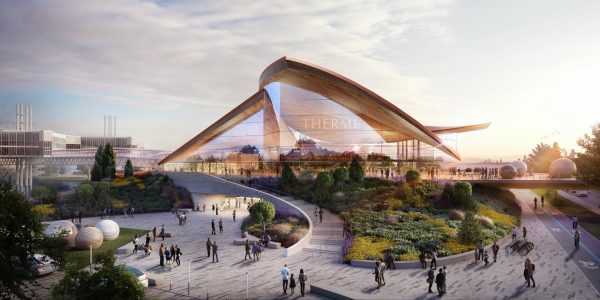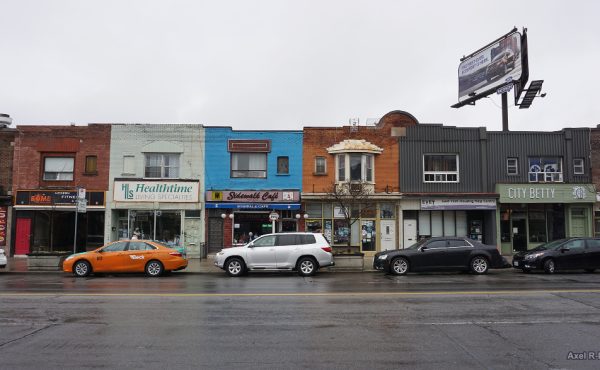
The only thing worse than the design proposed for Ontario Place’s indoor spa mega-project is the fact that a firm with such a storied history in Toronto urbanism would be willing to put its name to this terrible idea. Diamond Schmitt Architects Inc. (DSAI), the local partner retained by Austria’s Therme Group, which last year won the RFP to re-develop the site, has produced a design that’s not merely ridiculous, but profoundly and destructively anti-urban. They should be ashamed.
The whole fiasco landed last week on the agenda of Waterfront Toronto’s Design Review Panel, which must weigh in with recommendations about the so-called public realm master plan and then offer up a verdict by early next year. More public consultations are also planned for the coming months. The development application will be filed with the City in October, and this pathetic idea will find its way to the next council in the fall of 2023.
Make no mistake: the future of Ontario Place must become an election issue this fall, and it presents an opportunity for whomever is the next mayor to create either a strong built-form legacy or an epic failure that serves as a rebuke to more than a quarter of a century of civic-minded waterfront revitalization. I’ll talk about a possible solution more in a moment.
Let’s begin with DSAI’s concept plan for the spa, which will absorb a large chunk of the site, as my colleague Alex Bozikovic noted in an excellent thread on Saturday. The bird’s eye view rendering shows what appears to be two giant pinwheel-shaped structures topped by copper-coloured cladding. Of course, the reality of this massing will be experienced at grade, where it will overwhelm what’s left of Eb Zeidler’s airy original structure, as well as the pedestrians who dare to approach. The effect is this thing, as well as the expanded Live Nation concert venue, is to create a pair of looming, glacier-sized hulks blocking access to, and views of, the waterfront. They will look like a couple of beached whales.
We’ve made this mistake before, and one would hope, perhaps in vain, that we have learned something.

The notion that Therme’s spa will be a transparent structure is just fantasy. We got sucked into that particular bait-and-switch a almost generation ago with Daniel Libeskind’s renderings for the ROM “Crystal,” a fanciful selling point that seduced the museum’s board but then succumbed to the twin forces of value engineering and the elements.
It’s pure fiction to think one could build and then heat or cool a massive glass-enclosed structure on a waterfront that is frigid and windswept for six months of the year. The cost, economically and ecologically, is ruinous. In its built-out form, this spa, like other Therme projects, will be far more opaque than promise. I guarantee that the glass curtain walls that survive the value engineering won’t be facing the city; rather, we’ll get to stare at the ass of this thing for time immemorial. As the old saying goes, ‘fool me once, shame on you…’ etc.
The report that went to Waterfront Toronto’s DRP raises all the predictable issues around the urban design plan for what’s left of the site — a narrow ribbon of walkways around the edges, the marina, and a chunk of paved land on the east side that served as a drive-in theatre during the pandemic. The latter could become, as Urban Strategy Inc.’s draft public space plan notes, an “interim programming and event zone.” I wonder what that placeholder word “interim” implies.
This planning exercise, backed jointly by Infrastructure Ontario and the Therme Group’s local advisors, among them Urban Strategies (USI), is attempting to make a silk purse out of this sow’s ear. Zeidler’s iconic pods will likely be retained and gussied up. There’s a little beach. The Trillium Park, a terrific space dedicated by former Premier William Davis, remains as is. But so do the parking lots on the south side of Lakeshore. Because, you know, tourists.
In the main, Ontario Place will become far more private, exclusive, impermeable and inaccessible than it was in the years leading up to its demise. The new form will evoke none of the optimistic civic spirit that animated the original concept, which used, lest we forget, public funds to create a public space.
It’s critical that the members of Waterfront Toronto’s DRP give this indefensible scheme an unambiguous thumb’s down, and take a stand against an undertaking that runs dramatically counter to the principles that informed the creation of Waterfront Toronto way back in 2002. The DRP’s chair, Paul Bedford, knows those principles intimately because he helped draft them, and the waterfront secondary plan that followed. They turned on fundamental urban design goals, like accessibility, north-south view corridors, and the creation of a truly public water’s edge.
Another member of the DRP, architect George Baird, drafted some of Toronto’s earliest and most important view corridor protection bylaws, back in the 1970s. A third, Eric Turcotte, is a veteran partner at USI, whose founder, Joe Berridge, was instrumental in making the case for a waterfront development agency in the late 1990s.
Not that anyone involved should need to be reminded of the pre-history, but Waterfront Toronto exists specifically because of a chain of events set in motion by several view-destroying private development deals along Queen’s Quay West that were approved in secret by Toronto council in the mid-1980s. That debacle led to David Crombie’s royal commission on the waterfront, the renewed awareness of the intimate ecological relationship between the region and Lake Ontario, and a sturdy consensus that development shouldn’t privatize the lakefront.
Have we forgotten? Seems so.
In the years since, various actors have waded in to waterfront politics to defend the publicness of this vast space. The Ontario Municipal Board quashed a big box development proposal, complete with acres of parking, on a strategically vital parcel at the foot of Cherry Street. Later, city council, encouraged by thousands of citizens, pushed back hard against the Ford brothers’ grotesque 2012 scheme to turn the Port Lands into a vast shopping mall.
In 2018, Torontonians again balked at Google/Sidewalk Labs’ plan to create a quasi-private, heavily-surveilled neighbourhood at Quayside — a plan that was actually set in motion by Waterfront Toronto, and which went, well, sideways early in the pandemic. (For further details, see Josh O’Kane‘s forthcoming book of the same title.)
So here we are again.

One of the two leading candidates for mayor — incumbent John Tory and 8-80 Cities founder Gil Penalosa — will eventually have to cast a vote on the Therme scheme, and they’ll be able to do so equipped with the strong mayor powers promised by the Ford government.
Tory’s fingerprints are all over this file. The year Ontario Place closed, 2012, he was appointed by the then Liberal government to head a task force mandated to come up with ideas to revitalize the park. For much of his term as mayor, however, Tory didn’t do much about advocating for Ontario Place besides urging the province to work with the city, whatever that means. He opted instead to spend a bunch of his political capital on the $1.7 billion Rail Deck Park proposal that was eventually killed off through an appeal to the provincial land use tribunal.
More recently, he’s pledged his support to a long-odds plan to turn University Ave. south of College Street into a park. A cool idea, to be sure, but it’s almost impossible to imagine that the City, when push comes to shove, would do anything more ambitious than widen the median. Just look at what happened with ActiveTO and the Blue Jays.
Penalosa, for his part, came to Toronto over a decade ago after serving as the parks commissioner in Bogota, Colombia, so he knows a thing or two about public space. As the head of 8-80 Cities, he’s advocated for urban spaces that are open, accessible — place where, according to the group’s mission statement, “all people have the right to safe and active mobility, welcoming and accessible public spaces, and inclusive city-building processes.” Therme fails on all counts.
I’d like to see both of these men acknowledge the fatal flaw in the Ontario Place revitalization strategy, which is that any solution must necessarily generate revenue and include “attractions.”
Why? There is surely an overwhelming amount of evidence to show that public space is its own reward — a means of improving urban quality of life for all. We don’t expect High Park, Corktown Common or Trinity Bellwoods to generate cash flow. Tommy Thompson Park for decades has alchemized naturalized public space from construction debris, creating a unique, popular and eminently sustainable waterfront park. There are no municipal accountants trying to match the Leslie Street Spit’s operating expenses to its revenues.
During the pandemic, many Torontonians rediscovered Ontario Place, in all seasons, as an unprogrammed park where they could be outside, near the water, in the water, among the trees, and so on. Amidst the interesting dereliction of some of the older pavilions, nature is busy reclaiming parts of Ontario Place, as Francesca Bouaoun reported here last summer. I have no idea why, in the midst of a declared climate crisis, anyone would want to interrupt that wondrous process.
In short, the transformation of Ontario Place into a city park is a once-in-a-lifetime solution to a pressing public space crisis afflicting the rapidly intensifying downtown core. The answer is staring us in the eye.
What I’d like to see is the next mayor of Toronto use his or her new powers to halt this absurd process and propose a land-swap to the province: the Ontario Place islands in exchange for its parking lots and the parking lots across Lakeshore Blvd., on the Exhibition Grounds. Put Therme, with its promise of jobs and tourist dollars, up there, grandfather the amphitheatre, and then let the rest of Ontario Place evolve into the waterfront green space that it wants to become.
The next mayor must say, ‘no, not good enough for this city.’
We’ve arrived at a future-defining decision. We now need to elect someone with the vision and the courage to send the spa hucksters packing.





10 comments
It’s a cool project — and not something that Toronto has yet — so it’s no surprise that Lorinc and Bozikovic hate it. Can we have critics that are actually curious about change and progress? Cherry picking the worst renderings to prove over-stretched points is lame. You can see what other Therme Group spas look like online — they’re not the evil wastelands Lorinc spends so much time imagining.
This isn’t progressive urban commentary. It’s old men yelling at new neighbours.
The Ontario Green Party has an official policy to turn OP into an urban Provincial Park. The park should be the first step in revitalizing the Western beaches. As the largest city on the Great Lakes, we have a moral, financial and fiduciary responsibility to re-imagine what waterfront access should feel and look like. Pine tress not palm trees.
Thank You for this excellent article! We must save as much of the existing park as we can!
Great Article. Thanks for standing up for Ontario Place. This bulky burlesque is a perfect emblem of the Ford years (and Tory, too) – it must not be built. Ontario Place is an incredibly sensitive site, built by caring and skilled hands, and could still yield up lots of pleasures if treated well. This ill-thought-out scheme isn’t it.
I’d love to see Queen’s Park/University Ave and Ontario Place both turned into two new provincial parks befitting Ontario’s capital. I think the land swamp suggested here is realistic and leaves Exhibition Place as the primary place of spectacle while giving Toronto core some new and much-needed parkland. I don’t think anyone has much of an issue with Live Nation’s plans either as the gem of The Forum is now beyond most people’s memory. Ridding Ontario Place of its parking lot and extending the park space to Lake Shore Blvd could truly tie this all together.
Once again, the improvement of transit is apparently left out though yup, a set of older plans, and one in particular the WWLRT EA pointed out two demands: one local along waterfront, and another of larger-scale and more direct from High Park base to the core. We could likely create far more ‘park’ if we pushed for much more sensible transit than the Ontario Line ie. something truly serving King and the west end as per TTC plan a decade ago, and yes, get out to High Park so we could start having a car-free/congestion one in the old core and make the on-street parking park, in many areas.
But it’s Carontop…. no matter who gets in at City level because Dougtator and his Carservatives, tho most other parties aren’t too different.
Meh, why didn’t you think it was an election issue when Liberals closed the park?
I’m still not quite sure why they closed it without some sort of plan.
When it originally opened, was a bit dull… what did one actually do there?
Children’s village, coming slightly later, was cool, but long gone.
Forum was cool, but also long gone.
Pods haven’t had much use for a while.
Haida was pinched by Hamilton.
The waterpark was fun, but the “theme park” idea and price wasn’t attractive.
It might be a nice park, but one has to plod thru Exhibition place to get to it.
If this project is to be built by a European company then one thing is certain, that the use of it will be extremely expensive and in reality become more of a private site than public. Build the dam thing in Oakville, or someplace that needs a draw, Ontario place is already a busy city park space as it sits with virtually nothing going on there. It should be though of as a Public park and not some kind of highly commercial “amusement park”. It was called Ontario place for a reason, and the province, it’s history and nature should be reflected in whatever changes are to be made.
Passive and natural spaces is what the downtown waterfront and Ontario Place should be for – how about that for a ” theme park “. We already have the Exhibition lands directly north of Ontario Place which are well-suited for the amusement sector, which can be further developed.
The Province and the City should have a shared vision , one which recognizes that Ontario Place Place sits right in the middle waterfront precinct of highly urbanized Toronto. Don’t squander resources on circuses.
You and mayoral candidate Gil Penalosa are promoting moving Therme from Ontario Place to Exhibition Place grounds.
West Side Community Council (WSCC) comments on swapping Therme from Ontario Place to Exhibition Place:
1. In the past, developments at Exhibition Place were very ad hoc. We pushed the City to implement the Exhibition Place Master Plan now in Phase 2. The Province’s plans have partly derailed the Master Plan process with developments at OP and the Ontario Line. The Master Plan was created after years of community engagement. Is the intent of the Master Plan to be simply swept aside?
2. We’ve been pressuring the City and Ex Place for years to animate the site 365. This idea is finally incorporated into their Strategic Plan 2022-2026 – https://www.explace.on.ca/wp-content/uploads/2022/08/Exhibition-Place-Strategic-Plan-2022-2026-FINAL-August-12-2022.pdf
3. If Therme was to relocate to Ex Place this we suspect would open the flood gates for private interests like Maple Leaf Entertainment and other private interests to eat up more space (e.g. BMO expansion, Hotel X Phase 2, Horse Palace, Enercare expansion, etc.).
4. We know from meetings with the CNE and The Royal that they have ongoing issues with the Ex Place board and staff accommodating their interests. Both are struggling to recover from two years of Covid. (London has a large fairground that can accommodate The Royal. Charlie Johnstone, The Royal CEO, has had conversations with the London Western Fair District.) The CNE is 143 years old and The Royal is 100 years old. The size of the Therme proposal risks this heritage being preserved.
5. Where would this (Therme) frivolous entertainment complex (that serves only the interests of a demographic group that could just as easily access this entertainment anywhere else in the city) go on the Ex grounds? We just don’t see where it could be put without affecting the space required for the Ex, the Royal, Caribana, the Indy and any parkland expansion (so needed there!). The image presented situates Therme on the future site of the 20-acre Festival Plaza.
6. Ex Place displays, in glorious ways, over 250 years of colonial heritage. If there was ever a place that deserved some memorialization and historic recognition of the First Nations, this is it and putting more of the precious space available to the public into the hands of a private enterprise like Therme is just wrong.
7. We are pleased to see Waterfront Toronto has entered the conversation regards OP via the Design Review Panel. Let them play a bigger role. They have a history of good public consultations and development.
8. Therme is the contentious tenant at OP. Their plan is greenwashing. Less of a problem with Live Nation’s expansion to the existing site and Ecorecreo is small and fits more easily into the landscape. Ecorecreo has withdrawn – one down and two to go!
9. We wonder if arguing the swap won’t just derail and distract us from our collective efforts with no chance of happening anyway. Unless we totally misread the board and its mandate, we don’t see the board killing The EX or The Royal, et al, just to change the entertainment mix at OP. And Ford still controls OP’s future and could easily come up with some other hair-brained idea. We think the swap is an idea that is appealing in principle, but highly problematic in its execution. After all, the idea of the city “buying or swapping” OP has been kicking around forever.
Bruce Van Dieten’s monthly tour of Exhibition Place grounds is coming up on Sept. 18th at 1 PM – starting at Prince’s Gates.
You should come!
Reclaiming our Western Waterfront Parks – Keep Public Lands in Public Hands
http://www.EXcluded.ca
http://www.westsidecc.ca/